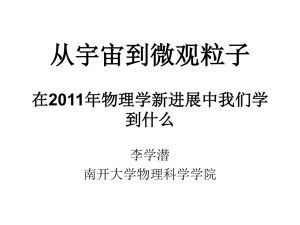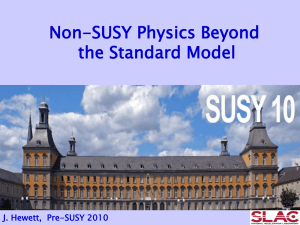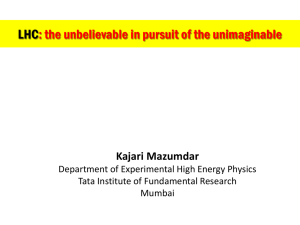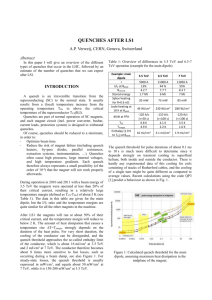energy of the lhc after the 2013-2014 shutdown - Indico
advertisement
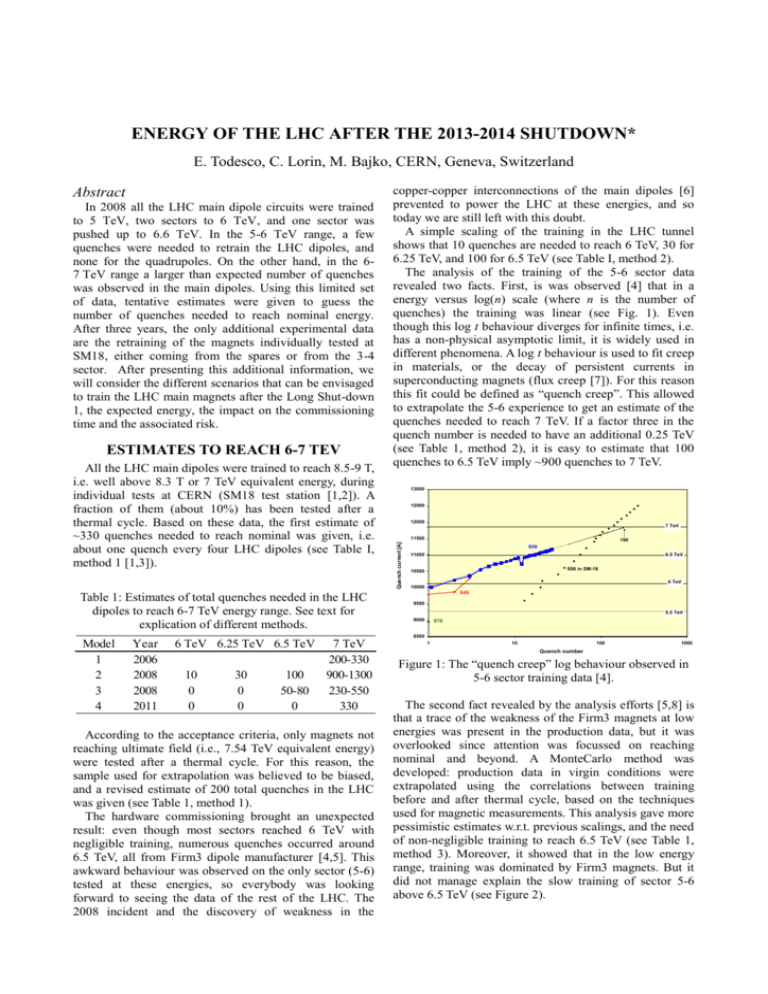
ENERGY OF THE LHC AFTER THE 2013-2014 SHUTDOWN* E. Todesco, C. Lorin, M. Bajko, CERN, Geneva, Switzerland In 2008 all the LHC main dipole circuits were trained to 5 TeV, two sectors to 6 TeV, and one sector was pushed up to 6.6 TeV. In the 5-6 TeV range, a few quenches were needed to retrain the LHC dipoles, and none for the quadrupoles. On the other hand, in the 67 TeV range a larger than expected number of quenches was observed in the main dipoles. Using this limited set of data, tentative estimates were given to guess the number of quenches needed to reach nominal energy. After three years, the only additional experimental data are the retraining of the magnets individually tested at SM18, either coming from the spares or from the 3-4 sector. After presenting this additional information, we will consider the different scenarios that can be envisaged to train the LHC main magnets after the Long Shut-down 1, the expected energy, the impact on the commissioning time and the associated risk. ESTIMATES TO REACH 6-7 TEV All the LHC main dipoles were trained to reach 8.5-9 T, i.e. well above 8.3 T or 7 TeV equivalent energy, during individual tests at CERN (SM18 test station [1,2]). A fraction of them (about 10%) has been tested after a thermal cycle. Based on these data, the first estimate of ~330 quenches needed to reach nominal was given, i.e. about one quench every four LHC dipoles (see Table I, method 1 [1,3]). Table 1: Estimates of total quenches needed in the LHC dipoles to reach 6-7 TeV energy range. See text for explication of different methods. copper-copper interconnections of the main dipoles [6] prevented to power the LHC at these energies, and so today we are still left with this doubt. A simple scaling of the training in the LHC tunnel shows that 10 quenches are needed to reach 6 TeV, 30 for 6.25 TeV, and 100 for 6.5 TeV (see Table I, method 2). The analysis of the training of the 5-6 sector data revealed two facts. First, is was observed [4] that in a energy versus log(n) scale (where n is the number of quenches) the training was linear (see Fig. 1). Even though this log t behaviour diverges for infinite times, i.e. has a non-physical asymptotic limit, it is widely used in different phenomena. A log t behaviour is used to fit creep in materials, or the decay of persistent currents in superconducting magnets (flux creep [7]). For this reason this fit could be defined as “quench creep”. This allowed to extrapolate the 5-6 experience to get an estimate of the quenches needed to reach 7 TeV. If a factor three in the quench number is needed to have an additional 0.25 TeV (see Table 1, method 2), it is easy to estimate that 100 quenches to 6.5 TeV imply ~900 quenches to 7 TeV. 13000 12500 12000 7 TeV 11500 Quench current [A] Abstract 190 S56 11000 6.5 TeV S56 in SM-18 10500 6 TeV 10000 S45 9500 5.5 TeV 9000 S78 8500 Model 1 2 3 4 Year 2006 2008 2008 2011 6 TeV 6.25 TeV 6.5 TeV 10 0 0 30 0 0 100 50-80 0 7 TeV 200-330 900-1300 230-550 330 According to the acceptance criteria, only magnets not reaching ultimate field (i.e., 7.54 TeV equivalent energy) were tested after a thermal cycle. For this reason, the sample used for extrapolation was believed to be biased, and a revised estimate of 200 total quenches in the LHC was given (see Table 1, method 1). The hardware commissioning brought an unexpected result: even though most sectors reached 6 TeV with negligible training, numerous quenches occurred around 6.5 TeV, all from Firm3 dipole manufacturer [4,5]. This awkward behaviour was observed on the only sector (5-6) tested at these energies, so everybody was looking forward to seeing the data of the rest of the LHC. The 2008 incident and the discovery of weakness in the 1 10 100 1000 Quench number Figure 1: The “quench creep” log behaviour observed in 5-6 sector training data [4]. The second fact revealed by the analysis efforts [5,8] is that a trace of the weakness of the Firm3 magnets at low energies was present in the production data, but it was overlooked since attention was focussed on reaching nominal and beyond. A MonteCarlo method was developed: production data in virgin conditions were extrapolated using the correlations between training before and after thermal cycle, based on the techniques used for magnetic measurements. This analysis gave more pessimistic estimates w.r.t. previous scalings, and the need of non-negligible training to reach 6.5 TeV (see Table 1, method 3). Moreover, it showed that in the low energy range, training was dominated by Firm3 magnets. But it did not manage explain the slow training of sector 5-6 above 6.5 TeV (see Figure 2). Current (kA) 7 TeV 11 Firm1 Firm2 Firm3 Firm2 HC Firm3 HC 6.5 TeV 10 9 8 0 20 40 First quench number 60 80 Figure 2: The MonteCarlo method to estimate training of sector 5-6, and hardware commissioning data [5]. After the 2008 incident, 32 magnets were removed from sector 3-4 and after minor repairs, not involving the active part of the magnet, were tested at SM18. Unfortunately, only 6 were from Firm3. This very limited sample showed a 20% probability of quench to reach 7 TeV for Firm1 magnets (i.e. one quench each five magnets), 27% for Firm2 and 33% for Firm3. No quenches were needed to reach 6.5 TeV. Extrapolation of these data gives 330 total quenches to reach 7 TeV (Table 1, method 4), in agreement with previous scalings of SM18 data (methods 1 and 2). In 2010 an additional effort on the modelling side has been done. A simple dynamical system based on the equilibrium between energy margin and frictional energy released during powering has been proposed [9]. This corresponds to a model that makes quantitative what is generally believed to the slip-stick mechanism of training. This model has an asymptotic performance limit, and one can prove that it is reached via an exponential in the number of quenches. It is curious to see the similarity with the situation of the decay of persistent currents, which is fitted though a log t behaviour or through an exponential behaviour. This model was shown to provide a good fit for the training of the LHC dipoles, with the exception of the initial part. To have a perfect fit of the data one has to change one of the model parameters to non-physical values. Em Energy E1 E2 Ef = α(I4-I14) E3 I2 I1 I3 I4 Iss Number of quenches in the LHC 12 These fits were then adapted to the scarce data relative to hardware commissioning to provide an estimate of the training needed to reach 7 TeV. Also in this case the result is around 900 quenches, but this is a pessimist estimate for Firm1 and Firm2 magnets, were no significant sample was available and therefore a lower bound based on 5-6 experience was considered. A summary of these different estimates show that negligible training is needed to reach 6 TeV, 0-50 quenches for 6.25 TeV and 0-100 quenches to 6.5 TeV (see Figures 3 and 4). Due to the very limited set of data, a large error is associated to these estimates. 1000 800 600 Scaling of production after thermal cycle MonteCarlo on production Scaling on hardware commissioning Scaling on magnets from 3-4 Prediction on HWC08 400 200 0 5.75 6 6.25 6.5 Energy (TeV) 6.75 7 Figure 3: Summary of estimates of needed training in the LHC dipoles to reach 6-7 TeV equivalent energy. RISKS A quench induces mechanical and thermal stresses in the superconducting coil. During the production, a weakness in the quench heater was found in some Firm2 magnets, causing the loss of the electrical integrity of protection circuits in four magnets. Thanks to the redundancy of the protection, this has not prevented operation of the LHC, and the four magnets will be replaced in 2013-2014 shutdown. Number of quenches in the LHC Sector 5-6: Montecarlo vs hardware commissioning 150 100 Scaling of production after thermal cycle MonteCarlo on production Scaling on hardware commissioning Scaling on magnets from 3-4 Prediction on HWC08 50 0 5.75 6 6.25 Energy (TeV) 6.5 Current Ef = α(I4-I24) Figure 3: Equilibrium between energy margin and frictional energy released during training quench [9]. Figure 4: Summary of estimates of needed training in the LHC dipoles, blowing of previous figure in the 6-6.5 TeV energy range. Even though each dipole was quenched several times during individual powering tests, a massive training in the tunnel soon after consolidation is not considered to be reasonable. Therefore one should find out an optimal level of training that minimizes the risks without affecting the performance. In 2010, about 100 quenches occurred in the main LHC dipoles at energies between 1.2 and 3.5 TeV [10]. These were not training quenches, but quenches provoked by firing of the protection system. Quench heaters were fired many more times (about 6000 times) without current in the magnet to test the protection system during hardware commissioning. A POSSIBLE STRATEGY Having outlined the best estimates for training and the related risks, we propose to aim at 6.5 TeV in the commissioning of the first four sectors [10]. This could imply about 10-15 quenches per sector. A training quench at 6-7 TeV provokes in general the quench of three adjacent magnets. This total number of quenches represents a very limited risk for the protection integrity in comparison with the number of quench heaters fired so far. During the 2008 training campaign, recovery times of the order of 8 hours were needed, and two training quenches per day were possible. Therefore 10 quenches per sector would take 5 days per sector, with a negligible impact on the schedule. According to the plan, four sectors could be trained by March 2014. Based on this experience, one could train the other sectors to 6.5 TeV or step back to 6.25 TeV if data show the need of a larger training. This would allow to fix the operational energy of the LHC in spring 2014, leaving a few months to the colleagues from experiments to run the MonteCarlo simulations needed for data analysis. According to the need of the experiments, and to the operational experience, a more massive training campaign to push the LHC towards 7 TeV could be foreseen for the second long shut down of 2018. This scenario of a first run at lower energy to minimize risks related to quench was already envisaged in 2004 [11]. ACKNOWLEDGEMENTS We wish to thanks M. Pojer for providing the quench data of the production, and V. Chohan, the SM18 team and the Indian collaboration for running the long and successful test campaign. A special thanks to A. Siemko for the technical discussions about training and for his warm support to our work. The only new data presented in this paper are related to the 3-4 magnets, provided by G. Dib and G. Deferne. These magnets were repaired by the 180 team led by P. Fessia and H. Prin. The information relative to quench heater firings were kindly provided by G. D’Angelo and E. Novak, and planning was discussed with K. Foraz. We wish to thanks F. Bordry, L. Bottura, L. Rossi, J. P. Tock, D. Tommasini and A. Verweij for discussions about this fascinating subject and about best strategies to bring the LHC towards the ambitious 7 TeV target. REFERENCES [1] P. Pugnat, A. Siemko, “Review of quench performance of the LHC main superconducting magnets”, IEEE Trans. Appl. Supercond. 17 (2007) 1091. [2] V. Chohan, “LHC magnet tests: operational techniques and empowerment for successful completion”, Particle Accelerator Conference (2007) 3742. [3] P. Pugnat, A Siemko, “Performance evaluation and quality assurance management during the series power test of the LHC main lattice magnets”, IEEE Trans. Appl. Supercond. 18 (2008) 126. [4] A. Verweij, “Training the dipoles” ”Magnet (re)training”, Proceedings of Chamonix workshop CERN-ATS-2009-001 (2009) 25. [5] B. Bellesia, N. Catalan-Lasheras, E. Todesco, “Magnet (re)training”, Proceedings of Chamonix workshop CERN-ATS-2009-001 (2009) 264. [6] M. Bajko, et al., “Report of the task force on the incident of 19th September 2008 at the LHC”, LHCProject-Report-1168 (2009) 40 p. [7] R. W. Hanft, et al. “Studies of time dependence of fields in Tevatron superconducting dipole magnets.” in IEEE Trans. Magnetics. Vol. 25, no. 2, pp 16471651, Mar. 1989 [8] C. Lorin, E. Todesco, “Training of the LHC main dipoles. Episode I: evolution during production, quench location and storage time”, CERN-ATS2010-164 (2010) p. 4. [9] C. Lorin, P. P. Granieri, E. Todesco, “Performance evaluation and quality assurance management during the series power test of the LHC main lattice magnets”, IEEE Trans. Appl. Supercond. 18 (2008) 126. [10] A. Siemko “Beam energy”, these proceedings. [11] R. Schmidt, M: Calvi, V. Kain, A. Siemko, “Operating the LHC initially at a lower energy”, Proceedings of Chamonix workshop, CERN-AB2004-014-ADM (2004) 227.

